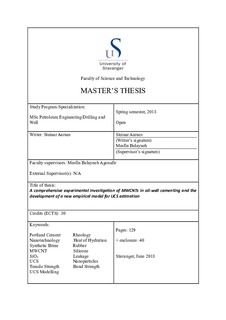| dc.description.abstract | Cement is the primary barrier in oil and gas wells and the NORSOK D-010 Standard have very specific requirements for said cement. Amongst others, it states that cement should be impermeable, ductile, strong and resistant to chemically erosive fluids and substances. However, a survey from 2001 states that about 15% of all primary cement jobs fail, [1, p. 14] and data released by the Petroleum Safety Authority (PSA) from the Norwegian Continental Shelf (NCS), in 2006, concluded that at least 11% of the well integrity issues originated from faulty cementing [2, p. 145]. This reveals that the conventional oil-well cement used today does not fulfill the requirements imposed by the NORSOK D-010 Standard. Nanotechnology has seen great developments within academics and applied research over the last decades, enticing the oil companies world-wide due to the viable and cost-effective solutions it offers. Carbon nanotubes, characterized as “the wonder material of the 21st century” [3], are renowned for their exceptional physical properties like its flexibility, strength and thermal conductivity and therefore possess a huge potential in cementitious composites that aims to improve one or more properties of hardened cement. In this thesis, a total of nine test matrices were designed and a number of cement slurries formulated using different water systems and adding varying concentrations of MWCNTs and rubber silicones. It was found that the addition of small amounts of MWCNTs (<0.08wt%) could increase the compressive and tensile strength of cement by 67% and 37% respectively and reduce the heat of hydration by 5% and experienced only 1% leakage after extensive thermal loading. Additionally, it was shown that an increasing concentration of MWCNTs (0-0.26wt%) can reduce the viscosity and shear stress of the cement slurry by 26.7% and 13.3% respectively. Salt water and synthetic brines have also shown promising effects on cement strength when used together with MWCNTs, increasing the UCS of at least 26%. In addition, the new empirical model developed to accurately predict the UCS of cement, shows approximately 90% precision compared to the old model that displayed up to 54% deviances. To further experiment with additives in cement, three rubber silicone elements were used (acid-treated and untreated) as cement replacements, and it was shown that when used in lower concentrations (1.5wt%) the UCS of cement experienced an increase ranging from 22%-40%. | nb_NO |
